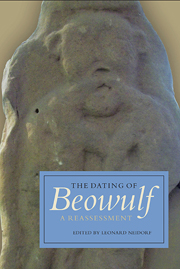Book contents
- Frontmatter
- Contents
- List of Tables
- List of Illustrations
- List of Contributors
- Acknowledgements
- Introduction
- 1 Beowulf and Language History
- 2 Germanic Legend, Scribal Errors, and Cultural Change
- 3 Names in Beowulf and Anglo-Saxon England
- 4 The Limits of Conservative Composition in Old English Poetry
- 5 The Date of Composition of Beowulf and the Evidence of Metrical Evolution
- 6 Beowulf and the Containment of Scyld in the West Saxon Royal Genealogy
- 7 History and Fiction in the Frisian Raid
- 8 ‘Give the People What They Want’: Historiography and Rhetorical History of the Dating of Beowulf Controversy
- 9 A Note on the Other Heorot
- 10 Beowulf and Conversion History
- 11 Material Monsters and Semantic Shifts
- 12 Scandals in Toronto: Kaluza's Law and Transliteration Errors
- 13 Afterword: Beowulf and Everything Else
- Index
3 - Names in Beowulf and Anglo-Saxon England
Published online by Cambridge University Press: 05 October 2014
- Frontmatter
- Contents
- List of Tables
- List of Illustrations
- List of Contributors
- Acknowledgements
- Introduction
- 1 Beowulf and Language History
- 2 Germanic Legend, Scribal Errors, and Cultural Change
- 3 Names in Beowulf and Anglo-Saxon England
- 4 The Limits of Conservative Composition in Old English Poetry
- 5 The Date of Composition of Beowulf and the Evidence of Metrical Evolution
- 6 Beowulf and the Containment of Scyld in the West Saxon Royal Genealogy
- 7 History and Fiction in the Frisian Raid
- 8 ‘Give the People What They Want’: Historiography and Rhetorical History of the Dating of Beowulf Controversy
- 9 A Note on the Other Heorot
- 10 Beowulf and Conversion History
- 11 Material Monsters and Semantic Shifts
- 12 Scandals in Toronto: Kaluza's Law and Transliteration Errors
- 13 Afterword: Beowulf and Everything Else
- Index
Summary
Passionate disputes over proper names in Beowulf began almost from the moment of its rediscovery and first publication in 1815. The poem's first editor, Grímur Jónsson Thorkelín, recognised the name of Scyld in line 4, translating Scyld Scefing as Scyldus Scefides. At line 26, however, perhaps thinking that verbal forms in barbarian vernaculars were too inconsistent to matter – an error of surprising longevity – he took scyld to be the past tense of sculan, and translated Scyld gewat as Ubi discedendum erat, “When it was time to leave.” He went on to transform the boat-burial into a piratical expedition. One of the seven reviewers of the edition, N.F.S. Grundtvig, noticed the error, but Thorkelín refused to accept the correction, and the ensuing angry correspondence in Nyeste Skilderie was terminated only by the journal's editor.
It could be said, though, that the problem began eight lines and eight hundred years earlier, for it is now generally accepted that the name Beowulf in line 18, and then line 53, is an error for Beow. The original manuscript's scribe A, coming upon the name, and knowing that the main hero of the poem he was about to copy was called Beowulf, seemingly assumed his copy-text was in error and “corrected” to the longer form. And – though this is not generally accepted – that may not have been his first proper-name error. All editors since Thorkelín have recognised that the poem's second sentence ends bathetically, in line 6.
- Type
- Chapter
- Information
- The Dating of BeowulfA Reassessment, pp. 58 - 78Publisher: Boydell & BrewerPrint publication year: 2014

